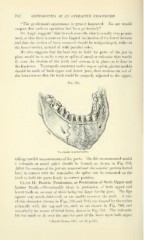Page 784 - My FlipBook
P. 784
782 ORTHODONTIA AS AN OPERATIVE PROCEDURE.
"The gentleman's appearance is greatly improved. No one would
suspect that such an operation had been perfonucd."
Dr. Angle suggests ' that in such cases the chin is usually very promi-
nent, so that there is more or less lingual inclination of the lower incisors
and that the section of bone removed should be wedge-shaped, wider at
the lower border, instead of with parallel sides.
He also suggests that the best way to hold the parts of the jaw in
place would be to make a cap or splint of metal or vulcanite that would
fit over the crowns of the teeth and cement it in place, as is done in
the fractures. To properly construct such a cap or splint, plaster models
should be made of both upper and lower jaws, then sections cut out of
the lower one so that the teeth could be properly adjusted to the upper^
Fig. 792.
Vulcanite or metal splint.
taking careful measurements of the parts. On this reconstructed model
a vulcanite or metal splint should be formed, as shown in Fig. 792.
After the sections of the jaw are removed and the anterior portion forced
back in contact with the remainder, the splint can be cemented on the
teeth to hold the parts firmly in correct position.
Class 11. Double Protrusion, or Protrusion of Both Upper and
Lower Teeth.—Occasionally there is protrusion of both upper and
lower teeth on account of their being too large for the jaws. The lips
appear very much thickened, or are unable to cover the teeth. A case
of this character (shown in Figs. 793 and 794) was treated by the writer
primarily with the cap and bit, such as are shown in Fig. 766, and
secondarily by means of labial bows, shown in Fig. 795. The vulcanite
bit was made to fit over the anterior part of the bows upon both upper
^ Dental Cosmos, 1898, vol. xl. p. 635.


